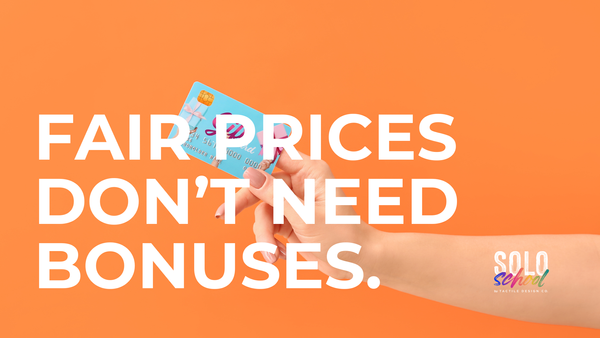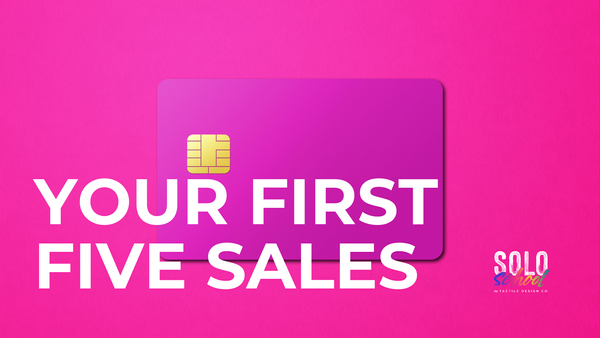It's the dream of every business owner:
A business that regulates your emotions and smooths out your life by being the one predictable, consistent thing in your otherwise chaos-filled existence.
Okay, maybe just the neurodivergent among us.
Repetition is where you take your chaotic, “I got clients this one time this one way" energy and attempt to turn it into a repeatable, reliable system that will persist through all of the wild energy you can throw at it.
We want to turn “I got five clients this one time" into “I have a system I can turn on when I need clients, and I maintain it often enough that it's not falling apart - without it taking over my entire life or ending up chronically online.”
That's it - that's the goal:
To get clients and customers predictably while still having time to touch grass.
So, how do we do this? Based on what we've developed, there are five steps we teach that make this easier for ND folx:
- Develop your repeat business systems (referrals and retention FIRST!)
- Plan your thought leadership content strategy
- Implement the thought leadership strategy with a project-based approach
- Design a simple conversion process
- Implement and test your conversion process
Through these five steps (that are not “simple" or “easy" or “overnight" or “in your pajamas" but reliably work and are more sustainable than a lot of other approaches) you'll start to build a lead flow that you can rely on to keep the lights on, while expanding your offer suite just a touch so you need fewer new clients to do so.
You'll also start to learn whether your existing clients are reliable sources of referrals, how to create content that your ideal clients respond to (without having to think up every new idea yourself - this is perfect for “responders"!), how to achieve the APPEARANCE of consistency without having to deal with the monotony of performing it, what sustainable lead gen looks like, and how your ideal clients prefer to say “yes" to your offers (without having to have 47-step autoresponder funnels and complex ad systems.)
It will take 3-6 months to be able to rely on your lead gen systems if you're moving quickly.
But think about where you were 6 months ago, and how that was literally January which still feels like yesterday. It's really not as long as it sounds. Okay?
Here's how we do it:
The Repeat Business Engine
It is 7x easier to sell something to an existing client than to find a new one.
It's also 7x cheaper.
The fact that your bank and cell phone company and employer all forget this when you've been loyal for two decades doesn't mean that isn't true. It just means that they're focused more on market share and acquisition because someone in a suit told them that would look better on quarterly shareholder reports.
You are your shareholder, and what looks best on your quarterly reports is not having to chase new leads all day while keeping your electricity connected. Right? Right.
So, before we start planting new seeds in our lead garden, we want to weed, water, and fertilize the harvest we already have.
Nevermind the fact that new people are always an unknown mix of masking, rejection triggers, and unknown / unpredictable behaviours, in addition to us tending to be more naive and oblivious to red flags, keeping the clients we have happy with us simply makes good business sense from a “I don't want to have to learn that this person is a jerk the hard way" perspective.
So, we want to make sure we do two things with our existing clients when it is mutually beneficial for both parties to do so - help them continue their work with us by spotting other things we can help with, and help them send their friends to us so they can look good.
People like making introductions. They like seeming like they “have a guy/gal/nonbinary pal" or “know somebody who can XYZ". Having a way to let your clients know when you have openings and availability allows them to be the person who has someone in their back pocket.
How to end every project
Hopefully by now, if you've been following what we teach, you're working with your first five clients on a project that solved all the problems you found during your initial offer - that strategy or assessment you did with them. Right?
Working with them on projects instead of retainers prevents a few problems for solo providers that can really wreck your day. Things like:
- All of your clients showing up and demanding work at the same time because it's right before their next installment and that reminds them you exist
- Being penalized for getting better at your craft, because your hourly can only go so high but you're finishing large tasks in minutes
- Clients demanding itemized lists of how you're using your hours, micromanaging you all the time and feeling like they can invade your privacy
- Starting to feel more like an employee than an expert
- Being treated more like an employee than an expert
- Being questioned constantly about whether you're doing the right thing, because you're being watched so closely, and the client wonders if they know better
Nevermind the fact that with retainers, you wonder every month whether they'll renew, so you're more on edge… And of course, you feel the pressure every month to provide top notch service so they continue.
By setting up a 3-6 month project with defined costs, specific deliverables, and a monthly payment plan, you know exactly how long you've got the client secured, what they're paying, what you're doing, and what is due when. You get more freedom and flexibility, they get more predictable outcomes and pricing, everybody wins.
So if this is what you're doing with every project, the key to ending every project with another one ready to go is to follow the anchor client life cycle:
- Inventory
- Assess
- Implement
- Measure
First, take stock of the entire current situation with the client. What do they have, what are they doing, what do they want, what resources do they have, etc.
Then assess. Will what they're doing now, get them where they want to go? What are the gaps? Identify ALL the gaps between where they are, where they want to be, and what's missing from their current action plan to make it happen. This should include an assessment of support and resources - aka why they probably can't do this on their own, and who they need to help them. The “who" is in terms of skills and services, not actual specific people.
This is what you did in the initial offer, as well, but now you're doing it as part of your project wrap up. You're updating this info and identifying new gaps, or ones that aren't quite closed yet, and what the next steps are.
Once you've got a full assessment of their progress, you show them.
You wanted to get from A → F this year. In three months, we've gone from A → C. Here's the proof. Here's why this is so huge! Now, to get from D → F, we need to do these steps. Did you want to see a proposal for how we could do that in another 3 months?
If you don't see opportunities to help them, don't offer this. It's unethical. We're not trying to push people into continuing to use our services exclusively for our benefit.
But if, upon assessment, you can see ways that they could use your help - frankly it's a disservice not to mention it. Why would you see that you can help someone and then say nothing?!?!
Create a process for how you will do this for each one of your projects, and follow it each time. You never know who will still need you, if you don't look!
Referrals On Purpose
You know how, as you get into your work more, clients will sometimes randomly drop a new project or client in your lap? You don't really know how, or why, and it seems totally random and unpredictable. You wish you could recreate this (because having your clients do your marketing for you and not having to do much marketing yourself sounds like the dream, right?) Unfortunately, it seems entirely random and outside of your control.
Do you know why it seems entirely random and outside of your control?
Because you're not intentionally seeking referrals!
You're not asking, or letting clients know what types of referrals you'd be open to, in any systemized way. So they're left not knowing when, or how, to recommend you to anyone.
I have had the MOST success with referrals by letting my clients know each month who I am open to working with, what I can do for them, and how to send people my way.
The simple phrasing I've used for 20+ years:
“Good people know good people, so I wanted to ask you. I've loved working with you, and I'd like to work with more people like you. I have one opening for someone who needs [XYZ service] in [MONTH]. It's best suited for someone with [ABC PROBLEM]. Do you know anyone like that?”
You can send this out to current and past clients the first time, and then some providers (and this WORKS! I have watched it WORK!) send out a monthly availability update to everyone who has ever expressed an interest in working with them. It typically includes:
- What services they're booking new clients for right now
- What they're offering to reward referrals (discounts, cash incentives, thank you gifts, etc.)
- Special discounts, rewards, or incentives for past or current clients who want those services themselves
It's a great way to keep your client base informed of what is available to them, but it is equally effective at letting them know who you'd like to work with and what you can offer them. Many of your favourite clients would send you referrals rigth now if they knew who, what, and how to do it!
Remember, the goal isn't to get a “yes” every time, it is to stay top of mind so they know how to refer to and support you.
Thought Leadership Content
Everybody wants to be a thought leader these days, but hold up. Pop quiz.
What is a thought leader?
It's okay. Everyone I have asked this question “on the spot" has struggled to answer it without stumbling. It's often some variation of “someone with thoughts and maybe a TEDx talk?”
While there's no “standard" definition of a thought leader, we take it literally. A thought leader is someone who is leading a body of thought on a topic.
And leaders? They don't do everything themselves.
A mentor once taught me that one of the best ways to have people see you as an authority on a topic was to build a stage, and share it with people who have great ideas. So, that's what we do to build reliable lead flow.
We're going to create a project-based, collaborative, community-led thought leadership strategy.
You're going to interview your ideal clients about their successes, their wins, their challenges, their ideas, and give them a platform. You're going to build a stage, and share it with them.
This works because:
- People love talking about themselves
- You no longer have to come up with a bunch of brilliant ideas all the time
- People will say yes to more of your invitations because you're offering visibility rather than asking for a sale
- You're creating content that will attract an audience of people just like your ideal clients
- You're building genuine relationships with the exact people you want to work with, and exploring their problems, challenges, and ideas
- You position yourself as someone who understands, supports, and celebrates your ideal clients
- AND, when appropriate, if you find opportunities to help them directly, you can make an invitation to a sales conversation (which they can affirm or decline, so there's consent!)
The best part is, these ideal clients are easy to find because the BEST ones are already trying to build influence. You'll see them guesting on other podcasts, writing on blogs, being featured in the media, and more.
If they're trying to get visible, and you can help them get even MORE visible, chances are they'll say yes to you!
And no. This isn't “bait and switch" because you're not drawing them in with the sole intention of selling them things. You genuinely want to create content with them.
Your ideal clients are the people that your budding audience wants to hear from, not a bunch of assembled “experts". You're building a body of helpful content for people, and a network of collaborators, partners, referral sources, and more!
If you happen to hear of a way you can help them, you are encouraged to offer a discussion - and nothing more, if they decline. But it is most certainly not the sole purpose of these connections, let alone the sole benefit.
Don't Do It Weekly
While this approach benefits executive dysfunction pretty automatically because you literally have “time to make content" appointments that are much harder to miss than the ones you make with yourself…
… we also have to realize that trying to do something every week consistently is also impossible and / or nightmare fuel. So, we don't.
We do it as a project.
Pick a focus for a body of content, whether that's a sub-group of your ideal clients, a specific problem you want to tackle, or a theme of questions you want to ask.
Pick a number of content pieces you want to create - a season of episodes is 10-12 for a podcast or blog, for example.
Then, produce it ALL in a little sprint - a concentrated period of time with a defined end date, so you know you don't have to keep going forever.
Schedule it out, and then take a break!
Design a Simple Conversion Funnel
Your content strategy is building relationships and visibility, but you need a clear path for interested people to work with you.
For most service providers in the Repetition stage, the best approach is a simple two-step funnel: valuable free resource (often, something you're creating in the course of your Thought Leadership strategy) that connects to your content, followed by an opportunity to book a sales call with you.
High-Converting Lead Magnets:
The most effective lead magnets for service providers are usually assessments or worksheets that help people identify gaps in their current approach.
Examples:
- A worksheet that goes with your podcast episodes: "Use this to analyze the results we discussed" → book a call to discuss their specific results and possibly buy an audit
- A template you use with clients: "Download this planning template" → book a call to have me help you fill it out for your situation, maybe buy a planning project
- An assessment that reveals needs: "Take this quiz to identify what's missing from your current strategy" → book a call to create a plan for addressing those gaps
Assessments work particularly well because they provide immediate value while naturally leading to a conversation about how you can help solve the problems they've identified.
For Product Businesses:
If you have a physical product, or a digital product that isn't information, your best opt-in is a discount code specifically for your “introductory" product - the one you're using to get everyone hooked, that either has multiple add-ons to purchase, refills to use, or limited editions to collect.
The Conversion Goal:
At this stage, success means calls are getting booked. That's it.
We're not trying to optimize complex email sequences or create elaborate sales funnels. We're trying to create a simple, clear path from "this content is helpful" to "I'd like to talk about working together."
If people are booking calls and some of those calls turn into clients, your funnel is working. If calls aren't getting booked, you need to adjust either your lead magnet or your call-to-action.
Implement and Test Your Conversion Strategy
Now you're going to build your simple funnel and start directing people to it from your content.
Building Your Funnel:
This doesn't need to be fancy. A simple landing page with your lead magnet, a thank you page with a calendar link, and a basic email sequence that delivers what you promised is enough to get started. And frankly, you don't even need the emails.
The goal is to test whether your approach converts, not to create a perfect system. You can always improve and automate later.
Testing and Refinement:
You'll know your system is working when you can consistently maintain 3-5 clients on your roster without the constant stress of wondering where your next client will come from.
Success at this stage means:
- Lead generation takes only 10-20% of your working time
- You have predictable conversations with potential clients
- Your client roster stays full without constant hustle
- You can focus 50% of your time on actual client work
When You're Ready for Expansion:
You'll know it's time to move to the Expansion stage when your lead flow starts to exceed your capacity to serve clients directly.
If you're turning down good clients because you don't have time, or if you're consistently booked out weeks in advance, you're ready to start thinking about leverage – either through people, technology, or different service delivery models.
But until you hit that point, your job is to make this system as smooth and sustainable as possible.
What Happens Next
Once you've built a reliable system for client retention, referrals, and lead generation that doesn't consume your life, you'll have something most entrepreneurs never achieve: a business that works for you instead of the other way around.
You'll know that you can generate ideal clients without spending all your time on marketing. You'll know how to create content that serves others while building your authority. You'll know how to turn prospects into paying clients without pushy sales tactics.
This means you're ready to move on to the Expansion stage of your business, where we explore ways to increase your impact and income without proportionally increasing your workload.
Sometimes, you'll discover that parts of your system need adjustment based on what you learn during implementation. That's normal and expected. The goal isn't to get everything perfect immediately – it's to build a foundation that you can refine and improve over time.
The Repetition stage can feel less exciting than Validation because the wins are more incremental and the work can feel, well, repetitive. But this is where you build the sustainable foundation that lets you grow without burning out.
Wish You Had Someone to Walk You Through It?
The Repetition stage is where a lot of entrepreneurs get stuck, because it requires building systems and maintaining momentum in ways that can feel overwhelming, especially for ND brains.
That's why Solo School exists – to support people just like you in becoming successful founders and entrepreneurs, with step-by-step guidance and community support that works with your natural tendencies instead of against them.
You can learn more about Solo School here.
If you're not ready for additional support yet, watch for next week's article on the Expansion stage to learn how we help students leverage their validated, systematized business models to increase impact and income without burning out.




